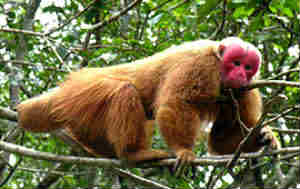Titis, Sakis and Uakaris: Hybrids
Family Pitheciidae
EUGENE M. MCCARTHY, PHD GENETICS, ΦΒΚ
Cacajao calvus [White Uakari]
× Cacajao melanocephalus [Black Uakari] CHR. CON: northwestern Brazil. C. rubicundus is known only from a region that lies between the ranges of C. calvus and Cacajao melanocephalus, which suggests it as a PHP of this cross.
× Cacajao rubicundus [Red-faced Uakari] CHR. CON: northwestern Brazil (R. Saliões between mouths of Ica and Japurá). These taxa are usually lumped (as in Duff and Lawson 2004), but sometimes treated as separate species (e.g., Szalay and Delson 1979, p. 290). International Zoo Yearbook 1982 (p. 412).
Cacajao rubicundus [Red-faced Uakari] See: Cacajao calvus.
Cacajao melanocephalus [Black Uakari] See: Cacajao calvus.
Note: Six titi populations (brunneus, cupreus, discolor, donacophilus, hoffmannsi, molloch) are parapatrically distributed south of the Amazon. They are treated as separate species by Duff and Lawson (2004), but are sometimes lumped under Callicebus molloch. Jones and Anderson 1978 (Fig. 3). Parapatry is often an indication of unreported hybridization.
Callicebus caligatus [Chestnut-bellied Titi]
× Callicebus cupreus [Coppery Titi] ENHR(South America). Hershkovitz (1988) described Callicebus dubius (Hershkovitz’s Titi) as a hybrid form derived from this cross. The range limits of C. dubius are still uncertain, but it is known to occur in southwestern Brazil on the right banks of the Purus and Ituxi rivers (Röhe and Silva 2009). It may also be present in adjacent northern Bolivia.
Callicebus cupreus [Coppery Titi]
See: Callicebus caligatus.
× Callicebus donacophilus [White-eared Titi] CHR. Five hybrids were reported. DRS. International Zoo Yearbook 1975 (p. 360).
× Callicebus ornatus [Ornate Titi] CHR. A male hybrid has been reported. DRS. International Zoo Yearbook 1975 (p. 360).
Callicebus donacophilus [White-eared Titi] See: Callicebus cupreus.
Callicebus dubius [Hershkovitz’s Titi] See: Callicebus caligatus × Callicebus cupreus.
Callicebus modestus [Beni Titi Monkey]
× Callicebus ollalae [Olalla Brothers’ Titi] These morphologically similar titis, which are both endemic to Bolivia, are in breeding contact, and Martinez and Wallace (2007) state that their “final taxonomic status remains unclear considering the potential formation of hybrid groups reported by Felton et al. (2006).”
Callicebus ollalae [Olalla Brothers’ Titi] See: Callicebus modestus.
Callicebus ornatus [Ornate Titi] See: Callicebus cupreus.
Chiropotes albinasus [White-nosed Bearded Saki]
× Chiropotes satanas (♀) [Brown Bearded Saki] CHR(Germany). CON: possibly in northern Brazil between the lower Xingu and Tocantins rivers. Zoo Köln had two hybrids. International Zoo Yearbook 1970 (p. 252), 1978 (p. 371).
Chiropotes satanas [Brown Bearded Saki] See: Chiropotes albinasus.
Pithecia monachus [Monk Saki]
× Pithecia pithecia [Guianan Saki] Parapatric contact zone on the Rio Negro (Brazil). Bode (1952) reported this cross, but the actual mating was between male and female P. pithecia, not a hybrid cross at all (P. pithecia females resemble P. monachus females).
Pithecia pithecia [Guianan Saki] See: Pithecia monachus.
By the same author: Handbook of Avian Hybrids of the World, Oxford University Press (2006).
